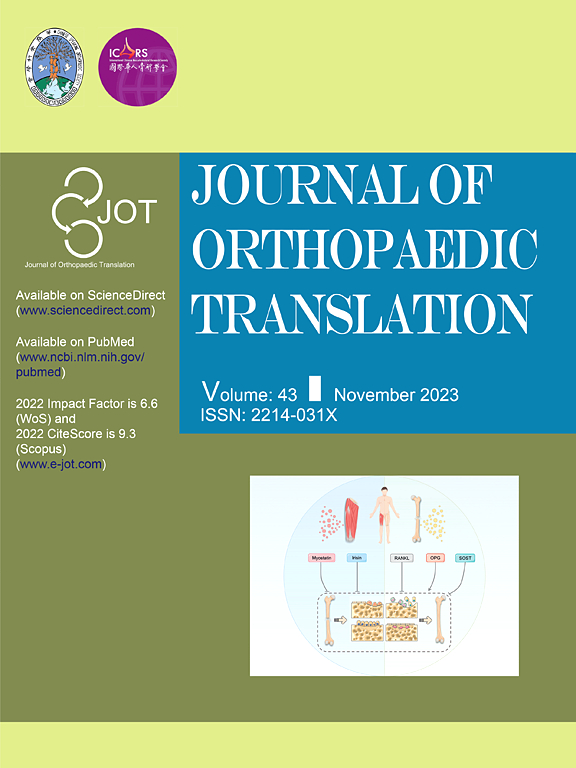Inhibition of ERK1/2 mediated activation of Drp1 alleviates intervertebral disc degeneration via suppressing pyroptosis and apoptosis in nucleus pulposus cells
IF 5.9
1区 医学
Q1 ORTHOPEDICS
引用次数: 0
Abstract
Objective
Dynamin-related protein 1 (Drp1) plays a crucial role in various inflammatory and degenerative diseases, yet its involvement in intervertebral disc degeneration (IVDD) remains poorly understood. This study aims to elucidate the mechanism by which Drp1 contributes to IVDD and to identify the efficacy of the Drp1 inhibitor Mdivi-1 on IVDD.
Methods
Tert-butyl hydroperoxide (TBHP) is utilized to induce an oxidative stress microenvironment in vitro. In vivo, IVDD model is constructed in 8-week old rats through puncture operation. The therapeutic effect of Mdivi-1 is evaluated through X-ray, MRI and histological analysis. A comprehensive set of experiments, including single-cell sequencing analysis, western blot, flow cytometry and immunofluorescence staining, are conducted to investigate the role and underlying mechanisms of Drp1 in vitro.
Results
Our study demonstrates that the expression of Drp1 and phosphorylated Drp1 (p-Drp1) are up-regulated in degenerative nucleus pulposus cells (NPCs), which are accompanied with increased pyroptosis and apoptosis. In vivo, both si-Drp1-mediated Drp1 knockdown and the pharmacological inhibitor Mdivi-1 alleviate puncture-induced IVDD in rats. In vitro, si-Drp1 or Mdivi-1 inhibits mitochondria-dependent apoptosis and pyroptosis triggered by TBHP. Mechanistically, Mdivi-1 reduces p-Drp1 levels, inhibits excessive mitochondrial fission, and mitigates mitochondrial dysfunction. Drp1 phosphorylation-based Drp1 mitochondrial translocation and subsequent apoptosis and pyroptosis are regulated by ERK1/2 phosphorylation in NPCs under oxidative stress condition.
Conclusion
This study highlights the involvement of Drp1 in the pathological progression of degenerative NPCs in IVDD, which is regulated by ERK1/2. Pharmacological inhibition of Drp1 with Mdivi-1 protects NPCs by promoting mitochondrial function and attenuating apoptosis and pyroptosis. These findings suggest that Mdivi-1 is a promising therapeutic candidate for IVDD treatment.
Translational Potential
By offering experimental evidence on the role and mechanism of Drp1 in IVDD, this study underscores the potential of Mdivi-1 as a therapeutic strategy for IVDD.

抑制ERK1/2介导的Drp1激活通过抑制髓核细胞的焦亡和凋亡来减轻椎间盘退变
目的动力蛋白相关蛋白1 (Drp1)在各种炎症和退行性疾病中起着至关重要的作用,但其在椎间盘退变(IVDD)中的作用尚不清楚。本研究旨在阐明Drp1促进IVDD的机制,并确定Drp1抑制剂Mdivi-1对IVDD的疗效。方法利用过氧化stert -butyl hydroperoxide (thbhp)诱导体外氧化应激微环境。在体内,通过穿刺手术建立8周龄大鼠IVDD模型。通过x线、MRI和组织学分析评价Mdivi-1的治疗效果。通过单细胞测序、western blot、流式细胞术、免疫荧光染色等综合实验,探讨了Drp1在体外的作用及其机制。结果我们的研究表明,Drp1和磷酸化Drp1 (p-Drp1)在退行性髓核细胞(NPCs)中表达上调,并伴有焦亡和凋亡的增加。在体内,si-Drp1介导的Drp1下调和药物抑制剂Mdivi-1均可减轻大鼠穿刺性IVDD。在体外,si-Drp1或Mdivi-1抑制thbhp引发的线粒体依赖性凋亡和焦亡。在机制上,Mdivi-1降低p-Drp1水平,抑制线粒体过度分裂,减轻线粒体功能障碍。氧化应激条件下NPCs中ERK1/2磷酸化调控Drp1线粒体易位及随后的凋亡和焦亡。结论本研究提示Drp1参与IVDD退行性NPCs的病理进展,该过程受ERK1/2调控。Mdivi-1对Drp1的药理学抑制通过促进线粒体功能和减轻凋亡和焦亡来保护NPCs。这些发现表明Mdivi-1是IVDD治疗的有希望的治疗候选药物。通过提供Drp1在IVDD中的作用和机制的实验证据,本研究强调了Mdivi-1作为IVDD治疗策略的潜力。
本文章由计算机程序翻译,如有差异,请以英文原文为准。
求助全文
约1分钟内获得全文
求助全文
来源期刊

Journal of Orthopaedic Translation
Medicine-Orthopedics and Sports Medicine
CiteScore
11.80
自引率
13.60%
发文量
91
审稿时长
29 days
期刊介绍:
The Journal of Orthopaedic Translation (JOT) is the official peer-reviewed, open access journal of the Chinese Speaking Orthopaedic Society (CSOS) and the International Chinese Musculoskeletal Research Society (ICMRS). It is published quarterly, in January, April, July and October, by Elsevier.
 求助内容:
求助内容: 应助结果提醒方式:
应助结果提醒方式:


